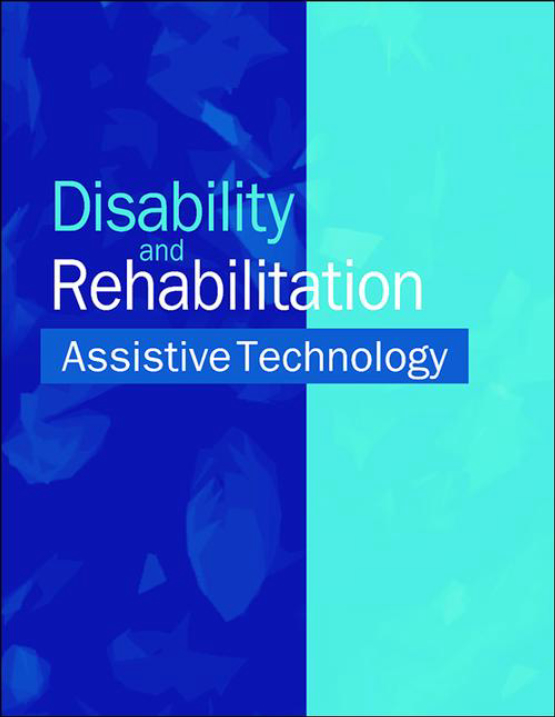Submit a Manuscript to the Journal
Disability and Rehabilitation: Assistive Technology
For a Special Issue on
AI-empowered Assistive Technology for Enhanced Human-Computer Interaction with Big Data
Manuscript deadline

Special Issue Editor(s)
Uzair Aslam Bhatti,
Hainan University, Haikou 570100, China
uzairbhatti86@hotmail.com
Muhammad Asim Saleem,
Faculty of Engineering, Chulalongkorn University, Bangkok 10330, Thailand
muhammadasim.s@chula.ac.th
Maqbool Khan,
Pak-Austria Fachhochschule-Institute of Applied Sciences and Technology, Mang, Haripur, 22621, Pakistan
maqbool.khan@scch.at
Sibghat Ullah Bazai,
Balochistan University of Information Technology Engineering and Management Sciences, Quetta, Pakistan
sibghat.ullah@buitms.edu.pk
Yonis Gulzar,
King Faisal University, PO Box 380, Al-Ahsa, 31982, Saudi Arabia Office: 2028
ygulzar@kfu.edu.sa
AI-empowered Assistive Technology for Enhanced Human-Computer Interaction with Big Data
AI can help HCI by offering intelligent tutors, adaptive feedback for learners, and individualised learning experiences. By providing patients with health monitoring, diagnosis, and treatment recommendations, AI can further improve HCI. It is anticipated that AI, which is already improving assistive technology, will open up new possibilities for users. Artificial intelligence enabled gadgets could help the blind, help those with speech difficulties communicate, and assist persons suffering from dementia in performing daily duties. This special issue introduction highlights the various monocular perspectives on interacting with intelligent systems. While HCI concentrated on enhancing the use of already existing algorithms, AI concentrated on creating new ones. Whereas HCI began in psychology, AI began in mathematics and engineering. Without requiring human involvement, robot interfaces using generative AI may identify, condense, translate, forecast, and produce content in response to a user inquiry.
Interaction between humans and AI can guarantee that AI systems are created and employed to complement human talents rather than to undermine or harm them. In addition to fostering meaningful and pleasant interactions, human AI contact can also advance collaboration and mutual understanding between humans and AI systems. Interaction between humans and computers is essential to keep things from failing entirely. It improves the usability, comprehension, and intuitiveness of systems for users. When a system is well designed with HCI principles in mind, its users won't actually have to worry about the way complicated it is. AI is commonly utilised to speed up the analysis of large data sets in data intensive businesses including banking and securities, pharmaceuticals, and insurance. AI is frequently used by financial institutions, for instance, to process loan applications and identify fraud. reduces labour costs and boosts output. The wide field of HCI includes topics including user interface design, user experience design, and user centred design. HCI was essentially the precursor to UX design. Whereas IT is concerned with the systems and infrastructure required to handle and process data, AI is concentrated on developing intelligent systems that are capable of independent thought and decision making. Artificial intelligence is capable of processing enormous volumes of data and making choices significantly more quickly than humans.
Artificial intelligence has a very high learning rate, but because it does not think logically, it cannot argue or dispute the facts in the same way that humans can. On the other hand, by allowing machines to produce human like explanations, descriptions, and contextual replies to visual input, big language models improve computer vision. This enhances AI systems capacity for communication while simultaneously facilitating more logical and organic human computer interactions. Because AI can predict user behaviour, interfaces become more dynamic and flexible. Conventional UI/UX design usually reacts to actions that the user initiates. AI has no inherent positive or harmful qualities. Depending on the way it is made and applied, this tool has the potential to be both useful and dangerous. The personalization and adaptability of AI systems will increase, enhancing user experiences even more. Contributions are invited from a range of disciplines and perspectives, including, but not restricted to: AI-empowered Assistive Technology for Enhanced Human-Computer Interaction with Big Data.
Submission Instructions
- Artificial intelligence techniques, algorithms, and sensors for intelligent human computer interaction.
- AI simulation as a factor in the creation and ethical evaluation of assistive technology.
- AI powered clinical decision support systems such as a human centred approach to design and assessment.
- Artificial intelligence with a human focus for creating cultural legacy that is easily accessible.
- A Machine Learning Based Dynamic Content Generation System for Fitness Games.
- Applications of AI and IoT in the design, construction, and upkeep of smart environments and buildings.
- Moving toward flexible and scalable cognitive AI frameworks for extensive multi agent human robot cooperation in learning.
- Creating a conceptual tool to aid in the transparent AI agent design process.
- Enhancing online collaborative learning performance with tailored recommendations and AI powered assessments.
- Intelligent teaching systems using artificial intelligence can lead to sustainable education.
- Business and ethical issues in home grown multi robot systems enabled by Conversational Generative AI.
- Internet of Things, Big Data, and Artificial Intelligence Applications in Sustainable Development
